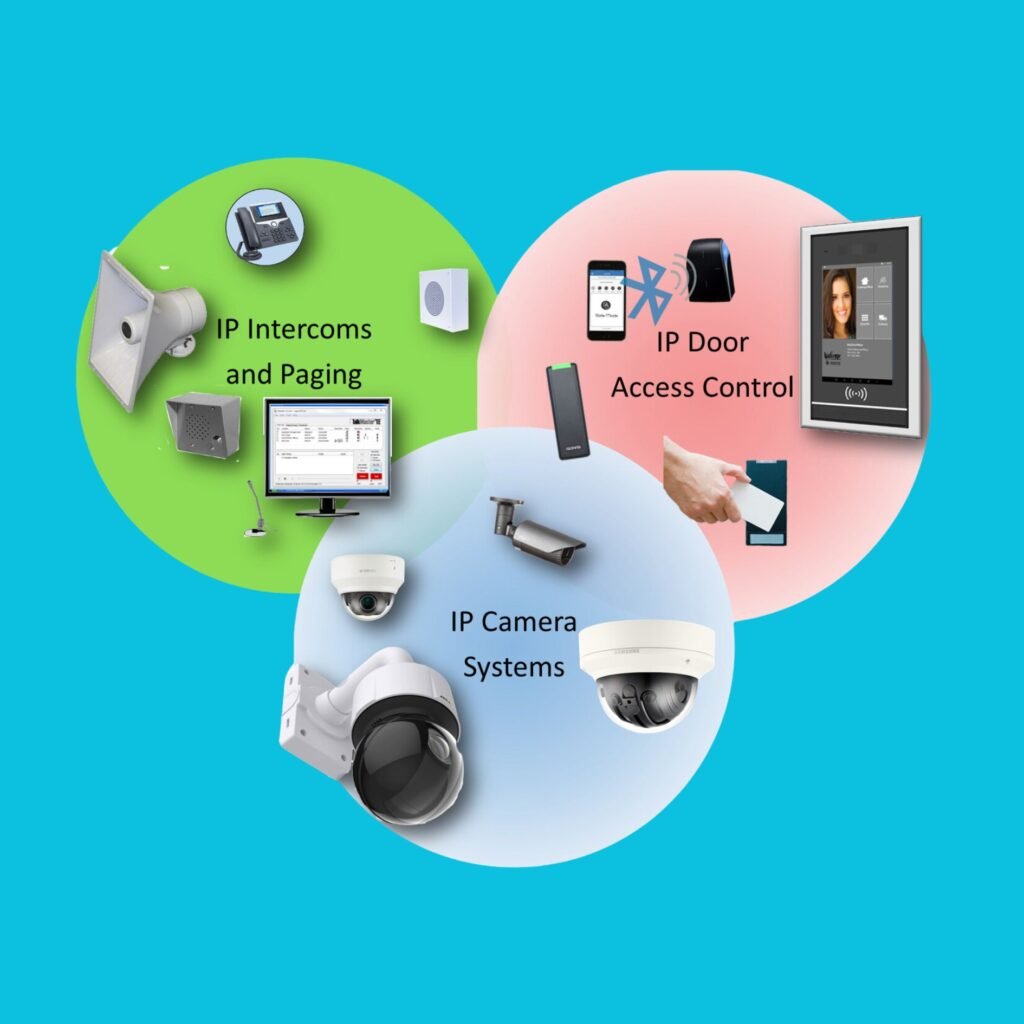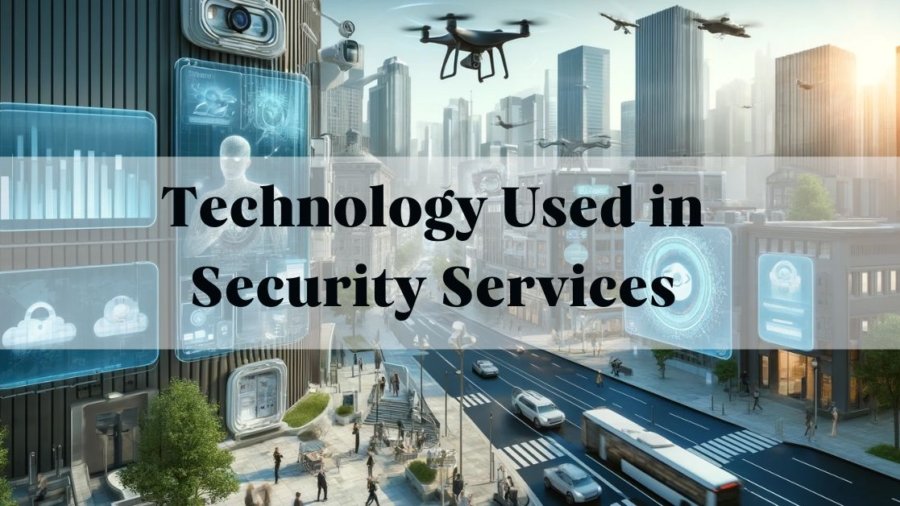The technology used in Security services plays a vital role in protecting our homes, businesses, and communities. But what fuels this protection? In today’s world, it’s not just about guard dogs and patrol cars. A sophisticated arsenal of technology underpins modern security services, offering a layered approach to deterrence, detection, and response.
This comprehensive guide dives into the diverse technologies employed by security companies, exploring how they work and the benefits they offer.
Physical Technology Used in Security Services: Building the First Line of Defense

Here are Some Examples of Physical Technology used in security Services:
Access Control Systems: These systems regulate who can enter specific areas. They come in various forms, including keycard readers, biometric scanners (fingerprint, facial recognition), and keypad entry systems. Access control systems grant or deny entry based on pre-programmed credentials, deterring unauthorized access and enhancing security perimeters.
Intrusion Detection Systems (IDS): These systems act as electronic sentinels, using sensors like motion detectors, door and window contacts, and glass break detectors to identify potential breaches. When triggered, an IDS can sound alarms, send alerts to monitoring centers, or both, allowing for a swift response to intrusion attempts.
CCTV (Closed-Circuit Television): This classic security technology has evolved into high-definition surveillance systems with remote viewing capabilities. Modern CCTV systems offer night vision, pan-tilt-zoom (PTZ) functionality, and remote recording, enabling comprehensive monitoring of a property from anywhere with an internet connection.
Security Fencing and Gates: Physical barriers like fences and gates form the first line of defense, creating a physical obstacle for intruders. Additionally, security fencing can be integrated with sensors that detect tampering or climbing attempts, further enhancing perimeter security.
Communication and Monitoring Technologies: The Nerve Center of Security
Alarm Monitoring Systems: These systems connect security panels to central monitoring stations. When an IDS or other security device is triggered, the system transmits an alert to the monitoring center, where trained professionals assess the situation, dispatch security personnel, or contact emergency services if necessary.
Two-Way Radios and Communication Networks: Security guards and personnel rely on reliable communication networks to maintain constant contact with each other and monitoring centers. Two-way radios, push-to-talk (PTT) applications, and cellular networks ensure efficient communication and coordination during security operations.
GPS Tracking Systems: These systems provide real-time location information for security vehicles and personnel on patrol. This allows for improved route optimization, faster response times to emergencies, and increased accountability for security teams.
Advanced Security Technologies: The Future of Protection
This type of Advanced Technology used in Security Services is given below:
Video Analytics: This technology uses artificial intelligence (AI) to analyze video footage from CCTV systems. It can detect suspicious activities like loitering, unauthorized entry, or unattended objects, allowing for more proactive intervention by security personnel.
Drones: Unmanned aerial vehicles (UAVs) or drones offer a unique perspective for security operations. They can be used for aerial surveillance of large areas, perimeter patrols, roof inspections, and rapid response to security incidents.
Cybersecurity Solutions: In today’s digital world, security threats extend beyond physical intrusions. Security companies offer cybersecurity solutions to protect client networks from data breaches, malware attacks, and unauthorized access. These solutions include firewalls, intrusion detection systems (IDS) for networks, and data encryption services.
Integration and Automation: A Symphony of Security Solutions
Modern security systems are no longer isolated tools. They are increasingly integrated, allowing them to communicate with each other and automate responses. For example, a triggered motion sensor can activate cameras, alert the monitoring center, and even lock down specific areas of a building, creating a coordinated and effective response to security threats.
Benefits of Utilizing Technology in Security Services:
These are some benefits of the technology used in security Services given below:
- Enhanced Deterrence: A visible presence of security technology discourages potential criminals.
- Improved Detection: Technology allows for 24/7 monitoring, increasing the likelihood of detecting security breaches.
- Faster Response Times: Real-time alerts and communication systems ensure a quicker response to security incidents.
- Increased Efficiency: Technology streamlines security operations, allowing personnel to focus on critical tasks.
- Improved Data Collection and Analysis: Security technology generates data that can be used to identify security trends and improve overall security strategies.
Choosing the Right Security Technology:
The specific security technology needs for a property or business will vary depending on factors like size, location, and security risks. It’s essential to consult with a professional security company to conduct a risk assessment and develop a customized security plan that leverages the most appropriate technology solutions.
The Future of Security Technology:
The security technology landscape is continually advancing, with innovative solutions constantly emerging to address evolving threats. From artificial intelligence and machine learning to data analytics, the tools at the disposal of security services are becoming increasingly sophisticated. Biometric identification, advanced video analytics, and seamless integration with the Internet of Things (IoT) are among the cutting-edge technologies used in the security services sector, enhancing capabilities and improving overall effectiveness.
The security industry has undergone a remarkable transformation with the integration of technology. Security services are no longer solely reliant on physical barriers and human patrols. Today’s security professionals wield a powerful arsenal of technological tools that deter crime, enhance detection, and facilitate swift responses.
By understanding and implementing the right technologies, businesses and individuals can create safer environments and achieve greater peace of mind.
Here are some additional points to consider:
- The Importance of Training: Technology is a powerful tool, but it’s only as effective as the people who use it. Security companies must invest in training their personnel on using security technology effectively, interpreting data generated by these systems, and responding appropriately to security incidents.
- The Human Element Remains Crucial: While technology plays an increasingly vital role, human expertise remains irreplaceable in security operations. Security guards with good judgment, strong communication skills, and the ability to assess situations are essential for effective security solutions. Technology should augment and empower security professionals, not replace them.
- Balancing Security with Privacy: As security technologies progress, concerns about privacy become more prominent. Companies and security service providers must ensure that security measures are implemented ethically and responsibly, respecting individual privacy rights.
By embracing a comprehensive approach that combines cutting-edge technology with well-trained personnel and a commitment to ethical practices, security services can continue to provide a vital safeguard for our homes, businesses, and communities in the ever-evolving landscape of security threats.
I hope this comprehensive look at the technology used in security services has been informative.
Read more blogs. written by Mobi.

